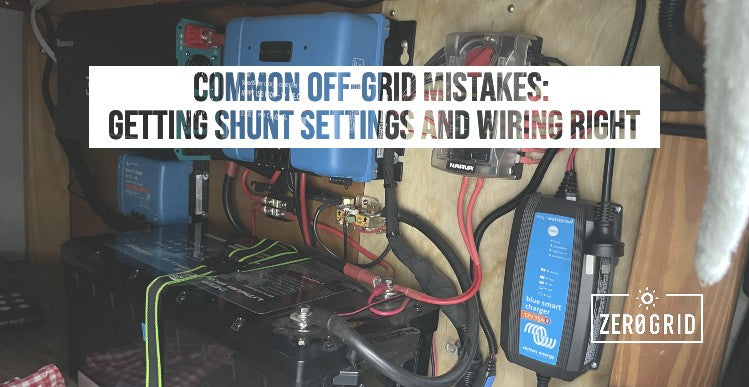Common Off-Grid Mistakes: Getting Shunt Settings and Wiring Right
Hey everyone, Landon here from ZeroGrid. Today, I want to share some common mistakes I often see in off-grid systems, particularly with shunt settings and wiring. Getting these right is key to ensuring your system is reliable and, most importantly, safe.
Check out this video where I explain everything in detail
What is a Shunt?
Let’s start with the basics—what exactly is a shunt? In simple terms, a shunt is like a flow meter for your battery. It monitors how much power is flowing through your off-grid system by doing some basic calculations. For example, if you have a 200Ah battery and you’ve used 50Ah, the shunt will indicate that your battery is at 75% capacity. This straightforward function makes proper setup crucial.
Common Mistake #1: Incorrect Wiring
One of the most frequent mistakes I see is incorrect wiring. In a DC electrical system, power flows in through the positive side and out through the negative side. All that power needs to pass through the shunt to be accurately measured.
However, it’s easy to miss this step. Even if you have the right shunt and settings, one of the charges might not be flowing through it, which throws off your readings. For example, if a charger isn’t connected properly, the shunt might show the battery is at full capacity when it’s not. The reverse can also happen, showing a full charge when the battery isn’t actually at 100%. Proper wiring is essential for accurate readings and understanding your system’s performance.

Diagram: Some loads not measured through the shunt, causing incorrect information being sent to the shunt and therefore readings being incorrect

Diagram: Correctly wired shunt with all loads going through the shunt
Common Mistake #2: Incorrect Shunt Settings
Another issue to watch out for is incorrect shunt settings. The shunt resets to 100% when it thinks the battery is fully charged. For instance, if you have a lithium battery with a charge rate of 14.6V, the shunt will mark the battery as fully charged once it holds that voltage for a minute or so. But if the shunt is set to 14.7V instead of 14.6V, it won’t recognize the battery as fully charged, leading to inaccurate readings.
It’s also crucial to set the correct battery capacity. If you have a 200Ah battery, make sure the shunt is set to 200Ah. It can be tricky since some batteries might not match their advertised capacity exactly, but following these guidelines will help you get as close to accurate as possible.
Final Thoughts
In summary, the two most important things to check in your off-grid system are the shunt settings and wiring. Making sure both are correct will help your shunt provide accurate readings, giving you a better understanding of your system’s performance.
These are the Shunts / Battery Monitors I recommend
Victron 500A SmartShunt- This is my favourite out of the bluetooth connection battery monitors, The Victron App on your phone works well and easy to operate. It can also talk to GX devices to log data or display on a touch screen.
Renogy 500A Battery Monitor- This is a simple screen that is hard wired in and shows all of the neccesiary information you need. Sometimes simplicity is best and want to be able to glance at a screen on the wall to see all the info we need
I hope this helps you keep your system running smoothly. If you have any questions or need further advice, feel free to reach out. Cheers!









6 Comments
I understand the principle that everything must run though the shunt for it to be able to monitor all loads. But with an inverter recommended to be connected direct to the lithium battery this is a bit confusing. If the inverter is to be connected to the negative bus bar and thus to the shunt – the. I need a huge bus bar. It would seem far more practical once the shunt is calibrated and calculating correctly to then connect inverter direct to the batttery? Could you clarify please? Regards Ed
I understand the principle that everything must run though the shunt for it to be able to monitor all loads. But with an inverter recommended to be connected direct to the lithium battery this is a bit confusing. If the inverter is to be connected to the negative bus bar and thus to the shunt – the. I need a huge bus bar. It would seem far more practical once the shunt is calibrated and calculating correctly to then connect inverter direct to the batttery? Could you clarify please? Regards Ed
I understand the principle that everything must run though the shunt for it to be able to monitor all loads. But with an inverter recommended to be connected direct to the lithium battery this is a bit confusing. If the inverter is to be connected to the negative bus bar and thus to the shunt – the. I need a huge bus bar. It would seem far more practical once the shunt is calibrated and calculating correctly to then connect inverter direct to the batttery? Could you clarify please? Regards Ed
Now I have.